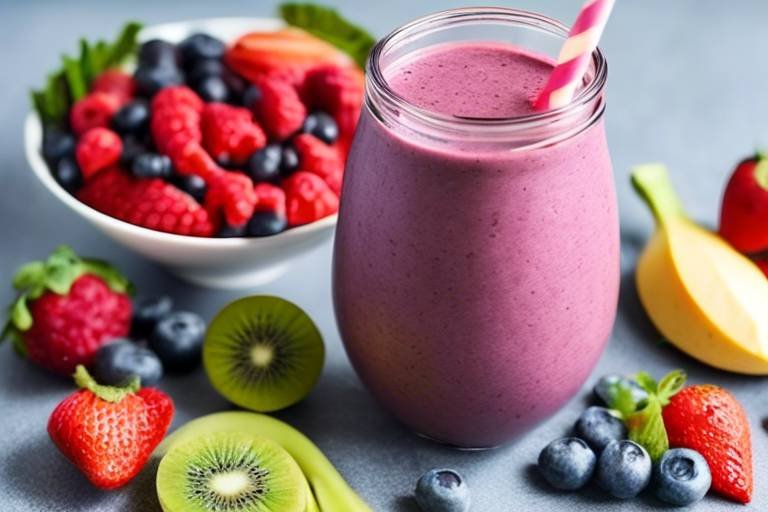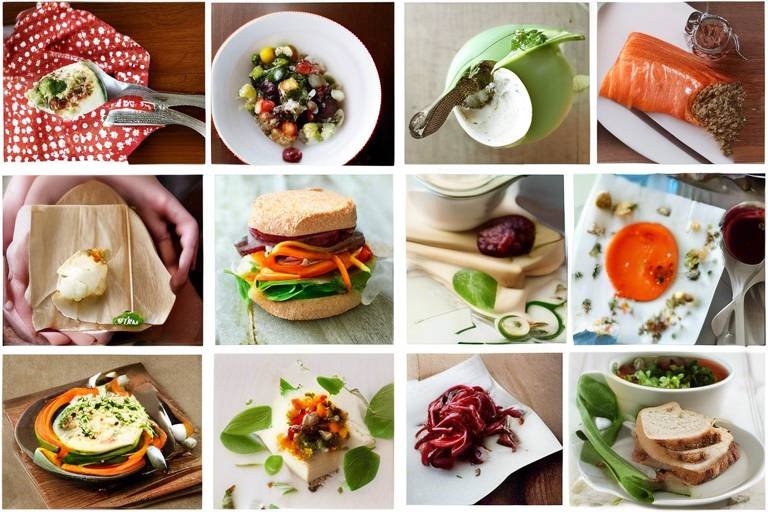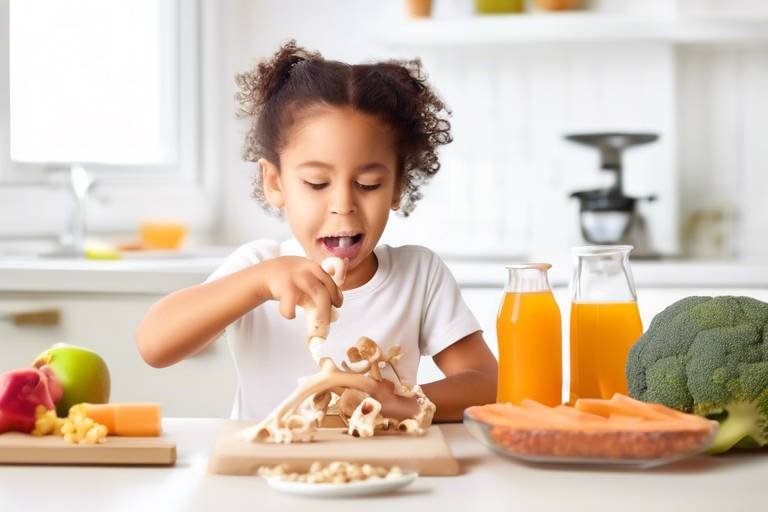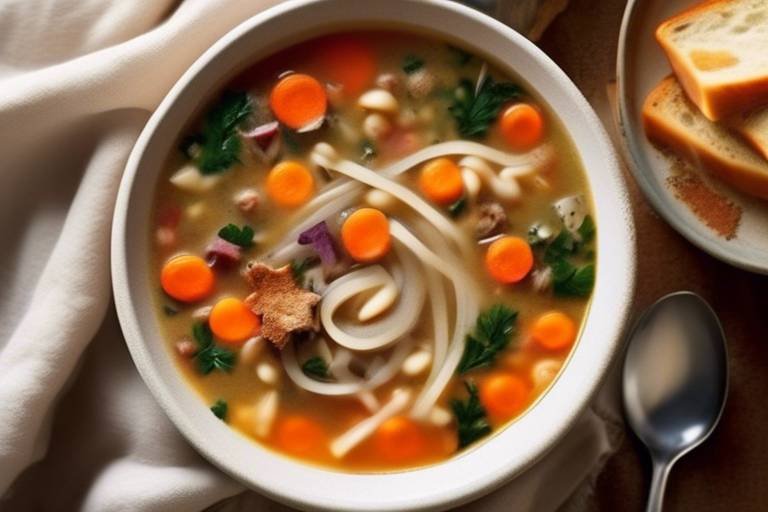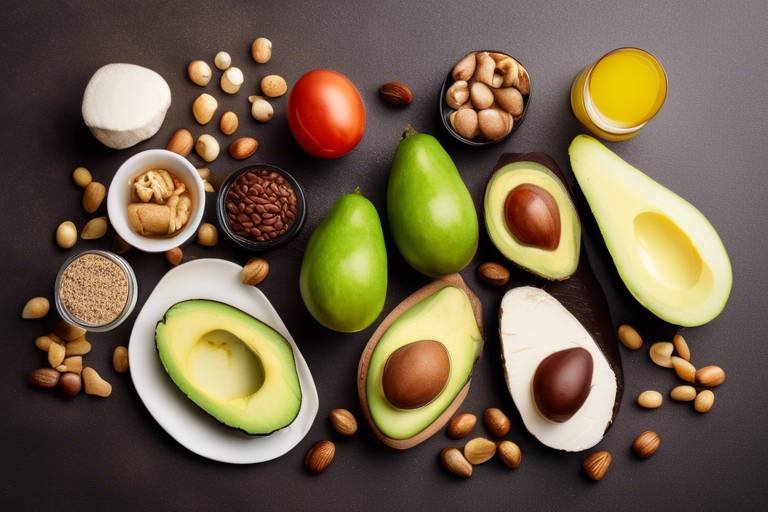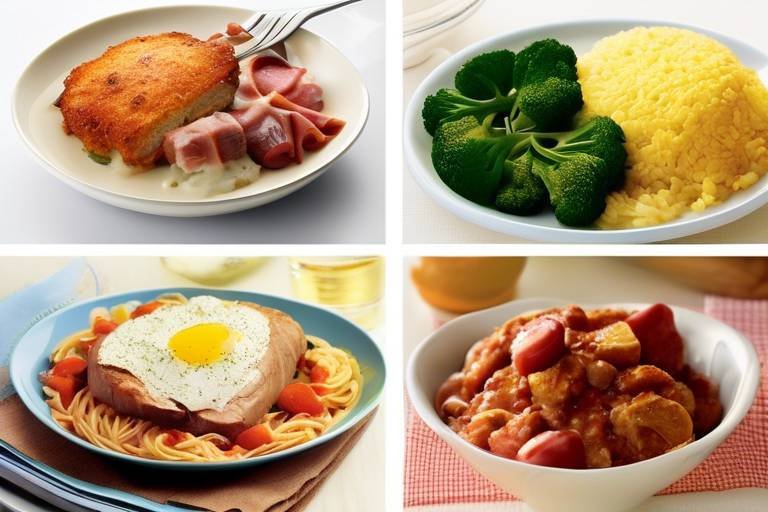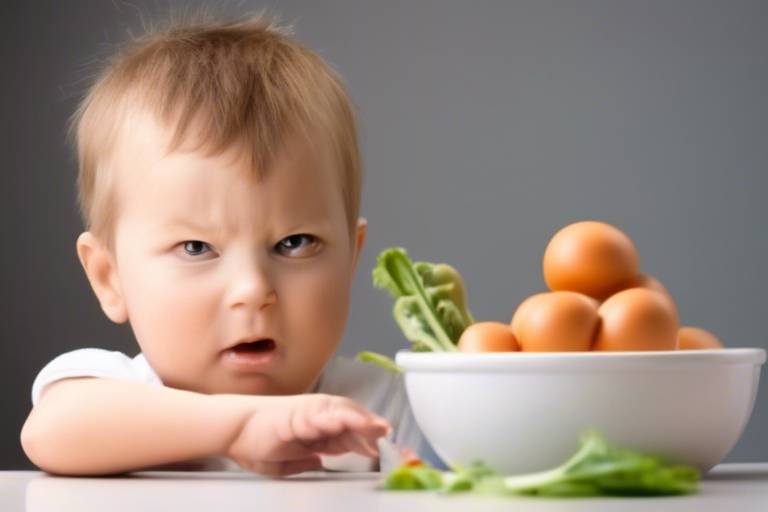Getting Kids Involved in the Kitchen: A Guide for Parents
Cooking with your children is more than just a way to prepare meals; it’s a fantastic opportunity to bond, teach, and create lasting memories. Imagine the laughter echoing through your kitchen as flour flies and ingredients are mixed with a little too much enthusiasm. Involving kids in the kitchen not only makes cooking more enjoyable but also opens the door to numerous benefits that can shape their future. From enhancing their motor skills to fostering a love for healthy eating, the kitchen can be a magical place for kids and parents alike.
When you cook together, you’re not just making food; you’re also nurturing your child’s development. Did you know that cooking can significantly enhance children’s motor skills? Tasks like chopping, stirring, and pouring help them refine their hand-eye coordination and dexterity. Plus, every time they successfully complete a task, their self-esteem gets a little boost. Cooking is also a fantastic way to promote healthy eating habits. When children are involved in preparing meals, they’re more likely to try new foods and develop a positive relationship with what they eat. And let’s not forget the incredible opportunity to strengthen family bonds. Sharing the joys and challenges of cooking together creates cherished memories that last a lifetime.
Understanding what your child can safely handle in the kitchen is crucial. Kids of different ages can take on various tasks, and knowing these can lead to a more enjoyable and safe cooking experience. Here’s a quick breakdown of age-appropriate kitchen tasks:
| Age Group | Tasks |
|---|---|
| Preschoolers | Washing vegetables, stirring, pouring ingredients |
| School-Aged Kids | Measuring ingredients, following recipes, preparing simple meals |
For preschoolers, the kitchen can be a playground of flavors and colors. Simple tasks like washing vegetables or stirring mixtures not only keep them engaged but also help develop their fine motor skills. Imagine your little one proudly washing carrots or stirring a pot of soup. It’s these small victories that build their confidence. To make it even more exciting, consider using fun and safe tools designed for little hands. Colorful, child-friendly utensils can transform cooking into a delightful adventure. Safety measures are essential, so opt for non-sharp knives and sturdy mixing bowls to ensure a secure environment while promoting creativity.
When it comes to recipes for preschoolers, simplicity is key. Think about easy, hands-on recipes like fruit salads or no-bake treats. These allow your little chefs to experience success in the kitchen, fostering a love for cooking from an early age. The joy of creating something delicious together can spark a lifelong passion for culinary arts.
As your children grow, their responsibilities in the kitchen can expand significantly. School-aged kids can take on more complex tasks, such as measuring ingredients, following recipes, and even preparing simple meals. This not only enhances their independence but also equips them with essential culinary skills that will serve them well in the future. Think of it as giving them the keys to a treasure chest of knowledge—one that they can unlock whenever they want to whip up something special!
Getting kids involved in meal preparation is a fantastic way to encourage them to try new foods and understand nutrition. When they participate in cooking, they become more open to tasting unfamiliar ingredients. It’s like giving them a backstage pass to the world of food! Discussing the benefits of various foods while you cook can make children more receptive to healthier options. For instance, while chopping broccoli, you might say, “Did you know this little tree is packed with vitamins that help you grow strong?”
Cooking together creates the perfect opportunity to introduce new ingredients. By discussing the nutritional benefits and fun facts about different foods, you can pique their interest. For example, talking about how colorful fruits and vegetables can make their meals not only tastier but also visually appealing can spark their curiosity. This way, you’re not just teaching them about food; you’re also instilling a sense of adventure in their eating habits.
As you cook, you can also teach your children how to create balanced meals. Discussing food groups and portion sizes helps instill lifelong habits of nutrition awareness. It’s like planting seeds of knowledge that will grow with them, guiding their food choices as they navigate through life. Imagine the pride they’ll feel when they can prepare a well-balanced meal for themselves or their friends!
Establishing regular cooking sessions can create cherished family traditions. These moments build lasting memories and strengthen family connections. Whether it’s a weekly pizza night or a monthly baking day, these rituals not only teach children the importance of teamwork and collaboration but also add a sprinkle of fun to your family life. So why not gather everyone in the kitchen and whip up something delicious together? The laughter and joy shared during these cooking adventures will be the heartwarming stories you’ll cherish for years to come.
- At what age can I start involving my child in cooking? You can start involving your child in cooking as early as preschool age, with simple tasks that are safe and fun.
- How can I ensure my child's safety in the kitchen? Always supervise your child, use child-friendly utensils, and assign age-appropriate tasks to minimize risks.
- What are some easy recipes for kids? Simple recipes like fruit salads, smoothies, and no-bake treats are great for kids.
- How can cooking together promote healthy eating? Cooking together encourages kids to try new foods and understand nutrition, fostering a positive attitude toward healthy eating.

Benefits of Cooking with Kids
Cooking with kids is not just about preparing meals; it's a delightful journey that brings a myriad of benefits for both children and parents. When you invite your little ones into the kitchen, you’re opening the door to a world of learning and fun. First and foremost, cooking enhances children's motor skills. As they chop, stir, and pour, they are developing fine motor skills that are crucial for their overall growth. Just think about it: every time they mix batter or roll dough, they're not just making a treat; they're honing their dexterity!
Moreover, engaging in cooking can significantly boost a child's self-esteem. When they successfully create a dish, their sense of accomplishment skyrockets. This feeling of success can translate to other areas of their lives, making them more confident in tackling new challenges. Picture this: a child who has mastered the art of making pancakes is likely to feel empowered when faced with a new school project or a challenging puzzle!
Another vital aspect of cooking together is the promotion of healthy eating habits. When children participate in the preparation of their meals, they become more aware of what goes into their food. This hands-on experience can lead to a greater appreciation for nutritious ingredients and a willingness to try new foods. For instance, if a child helps to make a colorful vegetable stir-fry, they are much more likely to taste those veggies than if they were merely served on a plate.
Not to mention, cooking together strengthens family bonds. These shared moments in the kitchen can create lasting memories, filled with laughter and teamwork. Imagine the joy of a family cooking night, where everyone pitches in to create a delicious meal. This not only fosters communication but also teaches children the importance of collaboration. They learn that cooking is not just a chore but a fun activity that brings everyone together.
In addition to these benefits, cooking can also teach valuable life skills. From following recipes to understanding kitchen safety, children gain practical knowledge that will serve them well into adulthood. They learn about measurement and time management as they figure out how long a dish takes to prepare. These skills are essential, not just in the kitchen, but in everyday life.
In conclusion, the benefits of cooking with kids are profound and multifaceted. It’s a wonderful way to nurture their development, instill confidence, and promote a healthy relationship with food. So why not roll up those sleeves and get cooking? Your kitchen can become a place of discovery and joy, where both you and your children thrive together!

Age-Appropriate Tasks
When it comes to cooking with kids, understanding is crucial. Each developmental stage brings its own set of skills and capabilities, which can be harnessed to create a fun and safe cooking environment. By assigning tasks that align with their abilities, you not only keep the cooking experience enjoyable but also foster a sense of accomplishment. So, what can each age group do?
For our little preschoolers, the kitchen is a playground of possibilities! They can engage in simple tasks like washing vegetables, stirring mixtures, and pouring ingredients. These activities are not just about getting dinner on the table; they are fantastic for developing fine motor skills. Just imagine your little one washing a carrot and giggling at the splashes of water! It’s a sensory experience that makes cooking fun and interactive.
As children transition into the school-aged category, their capabilities expand significantly. This is the perfect time to introduce more complex tasks like measuring ingredients, following simple recipes, and even preparing basic meals. For instance, a child around the age of 7 or 8 can learn to make a simple sandwich or scramble eggs. These tasks enhance their independence and build culinary skills that will serve them well into adulthood. It's like giving them a taste of freedom in the kitchen!
To help you visualize the tasks suitable for different age groups, here’s a quick table:
| Age Group | Tasks |
|---|---|
| Preschoolers (3-5 years) |
|
| School-aged (6-12 years) |
|
| Tweens (12+ years) |
|
It’s essential to keep safety in mind at every stage. For preschoolers, using child-friendly tools is a must. Look for colorful utensils that are designed for small hands, such as non-sharp knives and sturdy mixing bowls. These tools not only make cooking exciting but also ensure a safe environment for creativity to flourish.
As children grow and gain more confidence, you can gradually introduce them to more advanced tasks. This progression not only enhances their cooking skills but also instills a sense of responsibility and teamwork. After all, cooking is not just about preparing food; it's about creating memories and bonding as a family.
So, whether you’re washing vegetables with your preschooler or planning a week’s menu with your tween, remember that every little task is a step toward building their confidence and love for cooking. Let’s embrace the journey!
Q: What age should I start involving my child in cooking?
A: You can start involving your child in the kitchen as early as age 3! Simple tasks like washing vegetables and stirring can be fun and educational.
Q: How can I ensure my child's safety in the kitchen?
A: Always supervise your child while cooking, use child-friendly utensils, and teach them about kitchen safety rules, such as handling hot items and sharp tools.
Q: What are some easy recipes for kids?
A: Great options include fruit salads, no-bake desserts, sandwiches, and simple pasta dishes. These recipes are not only easy but also allow for creativity!

Preschoolers in the Kitchen
Getting your little ones involved in the kitchen can be a delightful adventure! Preschoolers are naturally curious and eager to explore, making them perfect candidates for cooking activities. When you invite them to join you, you're not just preparing a meal; you're creating a fun learning experience that can enhance their fine motor skills and boost their confidence. Imagine the joy on their faces when they get to stir a pot or pour ingredients into a bowl! These simple actions may seem trivial, but they are fundamental in developing coordination and dexterity.
As you embark on this culinary journey together, consider incorporating tasks that are both safe and engaging. For instance, washing vegetables is a fantastic way for preschoolers to contribute without any risk. They can also help with stirring mixtures, pouring pre-measured ingredients, and even setting the table. Each of these tasks not only provides a sense of accomplishment but also instills a love for cooking that can last a lifetime.
To make the experience even more enjoyable, equip your little chefs with fun and safe tools. Colorful, child-friendly utensils can turn cooking into a playful activity. Look for non-sharp knives designed for kids, which allow them to participate in chopping soft fruits or vegetables safely. Sturdy mixing bowls that won’t tip over easily can also add to the fun. Ensuring that your kitchen is a safe environment is crucial, as it allows preschoolers to express their creativity without fear.
When it comes to recipes, simplicity is key. Choose dishes that are easy to prepare, such as fruit salads or no-bake treats. These options not only allow preschoolers to experience success in the kitchen but also encourage them to taste what they've made. The satisfaction of creating something delicious can spark a lifelong passion for cooking. Plus, you’ll be creating cherished memories together, filled with laughter and learning.
In summary, cooking with preschoolers is a fantastic way to foster their development while having a blast in the kitchen. By assigning age-appropriate tasks, using safe tools, and selecting simple recipes, you can create an enriching environment that promotes creativity, confidence, and a love for food. So, why not roll up your sleeves and get cooking with your little ones? You might just discover that the kitchen is where the magic happens!
- What age is appropriate for kids to start cooking?
Generally, kids as young as 2-3 years old can start participating in simple tasks like washing veggies and stirring. As they grow older, they can take on more complex tasks.
- How can I ensure my child’s safety in the kitchen?
Always supervise your child while cooking, use child-safe utensils, and assign age-appropriate tasks to minimize risks.
- What are some easy recipes for preschoolers?
Consider recipes like fruit salads, yogurt parfaits, or no-bake cookies, which are simple and require minimal cooking.
- How can cooking with my child promote healthy eating?
Involving children in meal preparation can encourage them to try new foods and understand nutrition, fostering a positive attitude towards healthy eating.

Fun and Safe Tools for Preschoolers
When it comes to inviting preschoolers into the kitchen, having the right tools is essential for making the experience both fun and safe. Imagine a vibrant kitchen filled with colorful utensils that spark a child's imagination! Using child-friendly tools not only keeps the little ones engaged but also helps them feel like they are part of the cooking adventure.
One of the best ways to ensure safety is to select utensils specifically designed for young children. For instance, non-sharp knives made from plastic or other safe materials allow children to practice cutting without the risk of injury. Pair these with sturdy mixing bowls that won’t easily tip over, ensuring that the cooking process remains smooth and enjoyable.
In addition to non-sharp knives, consider using measuring cups and spoons that are brightly colored and easy to handle. These tools not only help children learn about measurements but also make the activity visually appealing. Having a set of fun aprons and chef hats can also enhance the experience, making kids feel like real chefs in their own kitchen.
Here’s a quick table summarizing some fun and safe tools for preschoolers:
| Tool | Purpose | Safety Feature |
|---|---|---|
| Non-Sharp Knife | Cutting fruits and vegetables | Made from plastic or soft materials |
| Colorful Measuring Cups | Measuring ingredients | Lightweight and easy to hold |
| Sturdy Mixing Bowl | Mixing ingredients | Non-slip base |
| Child-Friendly Peeler | Peeling fruits | Rounded edges |
By incorporating these fun and safe tools into your cooking sessions, you not only create a safe environment but also foster a sense of confidence and independence in your preschoolers. Remember, the goal is to make cooking a delightful experience that encourages creativity and learning while ensuring that safety is never compromised. So, let’s gear up and get cooking!
Q1: What age is appropriate to start cooking with my child?
A1: Many parents find that children as young as three years old can start participating in simple cooking tasks, such as washing vegetables or stirring ingredients.
Q2: How can I keep my child safe in the kitchen?
A2: Always supervise your child while cooking, use age-appropriate tools, and teach them about kitchen safety, such as keeping sharp objects out of reach.
Q3: What are some easy recipes I can try with preschoolers?
A3: Simple recipes like fruit salads, smoothies, or no-bake desserts are great choices. They allow children to participate without the complexities of cooking.
Q4: How can I encourage my child to try new foods?
A4: Involve them in the cooking process and discuss the benefits of various ingredients. Making food together often makes children more willing to try what they've helped create.

Simple Recipes for Preschoolers
When it comes to cooking with preschoolers, simplicity is key. Engaging little ones in the kitchen can be a delightful experience, especially when you choose recipes that are not only easy to follow but also fun to make. One fantastic recipe to start with is a fruit salad. Not only does this dish allow kids to explore different textures and colors, but it also introduces them to the concept of healthy eating. You can set up a mini fruit bar with a variety of fruits like bananas, strawberries, and blueberries. Just imagine the excitement on their faces as they get to choose their favorite fruits!
Another exciting option is no-bake treats. Recipes like chocolate-covered pretzels or yogurt parfaits are perfect for little hands. For a simple yogurt parfait, layer yogurt with granola and fruits in a clear cup. Let your preschoolers take charge of the layering process—this not only keeps them engaged but also teaches them about measuring and portioning. The beauty of these recipes is that they require minimal supervision, allowing for a more relaxed cooking experience.
Here’s a quick and easy recipe for a no-bake chocolate dessert that your preschoolers will adore:
| Ingredients | Measurements |
|---|---|
| Chocolate chips | 1 cup |
| Peanut butter | ½ cup |
| Oats | 2 cups |
| Honey | ¼ cup |
To make these delicious treats, follow these simple steps:
- In a microwave-safe bowl, combine the chocolate chips and peanut butter. Microwave for about 30 seconds, then stir until smooth.
- Add the oats and honey to the mixture, stirring until everything is well combined.
- Using your hands, roll the mixture into small balls and place them on a baking sheet lined with parchment paper.
- Refrigerate for about 30 minutes until firm, and then enjoy!
By involving preschoolers in these simple recipes, you not only make cooking a fun activity but also help them develop a sense of accomplishment. They’ll be proud to share their creations with the family, fostering a love for cooking that can last a lifetime. Remember, the goal is to create a joyful cooking atmosphere where learning happens naturally through hands-on experience!
So, gather your little chefs, roll up those sleeves, and get ready for some kitchen fun. You might just be surprised at how much they enjoy it—and how much you do, too!
Q: What age is appropriate to start cooking with my child?
A: You can start involving your child in the kitchen as early as age 2 or 3. Simple tasks like washing vegetables or stirring ingredients are perfect for preschoolers.
Q: How can I ensure my child’s safety in the kitchen?
A: Always supervise your child while cooking, use child-friendly utensils, and teach them about kitchen safety, including handling hot items and sharp tools.
Q: What are some other simple recipes I can try?
A: Besides fruit salads and no-bake treats, consider making smoothies, homemade pizzas with pre-made dough, or simple sandwiches where they can choose their fillings.

School-Aged Kids’ Responsibilities
As children progress into their school-aged years, they become more capable and eager to take on responsibilities in the kitchen. This is the perfect time for parents to step back a little and allow their kids to explore the culinary world with a bit more independence. Imagine your child measuring ingredients with precision or following a recipe almost like a little chef! Not only does this enhance their culinary skills, but it also boosts their confidence and sense of achievement.
At this stage, kids can handle a variety of tasks that are not only fun but also educational. For instance, they can start measuring ingredients accurately, which helps them understand concepts like volume and weight. This is a fantastic way to sneak in some math lessons without them even realizing it! Additionally, following recipes teaches them the importance of sequencing and organization—skills that are beneficial beyond the kitchen.
Moreover, school-aged kids can take on the responsibility of preparing simple meals. Think of dishes like scrambled eggs, sandwiches, or even a basic pasta dish. These meals are not only easy to make but also give children a sense of ownership over what they eat. When children prepare their own meals, they are often more willing to try new foods. This can lead to a more adventurous palate and a willingness to embrace a variety of flavors.
To ensure a safe and enjoyable cooking experience, parents should consider the following responsibilities that are appropriate for school-aged children:
- Measuring Ingredients: Kids can use measuring cups and spoons to get the right amounts for recipes.
- Following Recipes: They can read and understand simple recipes, which helps improve their reading skills.
- Preparing Ingredients: Tasks such as washing vegetables, peeling fruits, or grating cheese are great for developing fine motor skills.
- Cooking Techniques: As they progress, they can learn to use the stove or oven under supervision, which is a significant step towards independence.
Involving school-aged children in these responsibilities not only teaches them valuable cooking skills but also instills a sense of pride in their abilities. Plus, it opens up opportunities for conversations about nutrition and healthy eating habits. As they learn to prepare meals, parents can discuss the importance of using fresh ingredients and balancing different food groups. This knowledge is essential for fostering a lifelong appreciation for healthy eating.
Ultimately, cooking with school-aged children is about more than just food; it’s about creating lasting memories. Picture this: a Saturday afternoon filled with laughter, flour flying, and the sweet aroma of cookies baking in the oven. These moments become cherished family traditions that your kids will remember fondly as they grow up. So, let them take the reins a bit, and watch them thrive in the kitchen!
Q: At what age can my child start cooking?
A: Children can start helping in the kitchen as early as preschool age, but their responsibilities can increase as they grow older. School-aged kids are typically ready for more complex tasks.
Q: How can I ensure my child is safe while cooking?
A: Always supervise your child in the kitchen, especially when using sharp utensils or hot surfaces. Teach them about kitchen safety and the importance of cleanliness.
Q: What are some easy recipes to start with?
A: Simple recipes like fruit salads, smoothies, or no-bake desserts are great for beginners. As they gain confidence, you can introduce more complex dishes.
Q: How can cooking together benefit our family?
A: Cooking together promotes teamwork, strengthens family bonds, and creates lasting memories. It’s a wonderful way to connect with your children while teaching them valuable life skills.

Encouraging Healthy Eating Habits
Involving kids in meal preparation is not just about cooking; it's a golden opportunity to instill healthy eating habits that can last a lifetime. When children participate in the kitchen, they become more curious about the food they eat. Have you ever noticed how kids are more likely to try something new when they've had a hand in making it? It’s like magic! By engaging them in the cooking process, you’re not just teaching them how to whip up a meal; you're also fostering a positive attitude towards nutrition.
One of the most effective ways to encourage healthy eating is by introducing new ingredients during your cooking sessions. Picture this: you’re preparing a vibrant stir-fry, and you ask your child to help choose the vegetables. As they pick out colorful bell peppers, broccoli, and snap peas, you can talk about the health benefits of each ingredient. For instance, did you know that broccoli is packed with vitamins K and C? This not only makes the cooking experience interactive but also empowers children to make better food choices. They learn that food is not just fuel; it's a source of energy and health!
Moreover, creating balanced meals together can be a fun and educational experience. You can teach your children about different food groups and the importance of portion sizes. A simple way to illustrate this is by using a plate model. You can divide a plate into sections for fruits, vegetables, grains, and proteins. This visual aid helps kids understand what a balanced meal looks like and encourages them to fill their plates with a variety of healthy options. Here’s a quick breakdown:
| Food Group | Examples | Benefits |
|---|---|---|
| Fruits | Apples, Bananas, Berries | Rich in vitamins and antioxidants |
| Vegetables | Carrots, Spinach, Broccoli | High in fiber and essential nutrients |
| Grains | Brown rice, Quinoa, Whole wheat bread | Good source of energy and fiber |
| Proteins | Chicken, Beans, Tofu | Essential for growth and muscle development |
By making these discussions part of your cooking time, you’re not just preparing meals; you’re also preparing your children for a healthier future. They’ll start to recognize the importance of nutrition and may even become the ones reminding you to include more veggies in the next meal!
Establishing these habits early on can significantly influence their relationship with food as they grow. Instead of seeing healthy eating as a chore, they’ll view it as a fun and rewarding experience. Plus, cooking together creates a bond that strengthens family ties. So grab those aprons, roll up your sleeves, and dive into the kitchen with your kids. You’ll be amazed at how much they learn and how much fun you’ll have!
- What age should I start involving my kids in cooking? You can start as early as preschool age, with simple tasks that match their developmental abilities.
- How can I make cooking fun for my kids? Use colorful utensils, let them choose ingredients, and pick fun recipes that are easy to follow.
- What if my child is picky about food? Involve them in the cooking process and introduce new foods gradually; they may be more willing to try things they helped make!

Introducing New Ingredients
Cooking together is not just about whipping up a delicious meal; it’s also a fantastic opportunity to introduce your children to new ingredients. When you involve kids in the kitchen, you can turn an ordinary cooking session into an exciting adventure of discovery. Imagine their eyes lighting up when they see a bright purple eggplant or a vibrant green zucchini for the first time! By incorporating new ingredients, you can spark their curiosity and encourage them to explore a world of flavors.
One effective way to introduce new ingredients is to create a “mystery box” challenge. Fill a box with various fruits, vegetables, and grains that they may not have encountered before. Let your kids pick one or two items to cook with. This not only makes them feel involved but also allows them to take ownership of their culinary creations. As you cook, engage them in conversations about the ingredients. Ask questions like:
- “What do you think this will taste like?”
- “How do you think we can prepare this?”
- “What color do you think this will turn when we cook it?”
These questions not only stimulate their imagination but also enhance their understanding of food. Discussing the nutritional benefits of each ingredient can also pique their interest. For instance, explain how carrots are great for their eyesight or how spinach can make them strong, just like their favorite superheroes!
Another engaging way to introduce new ingredients is through themed cooking nights. For example, you could have an Italian night where you explore different types of pasta and sauces, or a Mexican night featuring various beans and spices. This approach not only broadens their palate but also exposes them to different cultures and cuisines. You could even create a small
to keep track of the new ingredients you’ve tried together:| Ingredient | Type | Kid's Reaction |
|---|---|---|
| Quinoa | Grain | Excited to try! |
| Beets | Vegetable | Curious about the color! |
| Mango | Fruit | Delighted by the sweetness! |
By keeping track of their reactions, you can revisit their favorites and find ways to incorporate them into future meals. This not only makes cooking fun but also helps your children develop a positive relationship with food.
Lastly, don’t forget to celebrate their culinary achievements! Whether it’s a simple fruit salad or a complex stir-fry, acknowledging their efforts can boost their confidence and motivate them to keep trying new things. Who knows? You might just create the next generation’s top chef!
Q: How can I make my child more willing to try new foods?
A: Involve them in the cooking process and make it fun! Use games or challenges to introduce new ingredients, and highlight the nutritional benefits in a playful way.
Q: What if my child refuses to try a new ingredient?
A: It’s completely normal for kids to be hesitant. Encourage them to taste it without pressure. Sometimes, simply seeing it prepared in a dish can spark their interest.
Q: How often should I introduce new ingredients?
A: Aim for once a week to keep things fresh and exciting. Consistency helps create an open-minded approach to food.

Creating Balanced Meals
Creating balanced meals is not just about filling plates; it's about teaching your children the fundamentals of nutrition in a fun and engaging way. When you involve your kids in meal preparation, you open the door to conversations about the different food groups and their importance in our diets. For instance, you can explain how proteins help build muscles, while carbohydrates provide the energy they need to play and learn. This kind of dialogue not only educates them but also empowers them to make informed food choices.
To make the concept of balanced meals more digestible for children, consider using a visual approach. You might create a colorful poster that illustrates the various food groups and their respective portions. A simple breakdown could look something like this:
| Food Group | Examples | Recommended Portions |
|---|---|---|
| Fruits | Apples, Bananas, Berries | 1-2 servings |
| Vegetables | Carrots, Broccoli, Spinach | 2-3 servings |
| Proteins | Chicken, Beans, Eggs | 1-2 servings |
| Grains | Rice, Bread, Pasta | 3-4 servings |
| Dairy | Milk, Cheese, Yogurt | 2-3 servings |
As you prepare meals together, encourage your kids to pick ingredients from each food group. Ask them questions like, “What color do you want to add to our salad?” or “Which protein do you think would taste best with this dish?” This not only makes them feel involved but also helps them understand the importance of variety in their diet.
Another great way to teach about balanced meals is through experimentation. Let your children take the lead in creating their own meals. You could set up a “build-your-own” station where they can choose from a selection of ingredients across the food groups. For example, they might assemble their own tacos using whole grain tortillas, lean protein like turkey, a variety of colorful veggies, and a sprinkle of cheese. This hands-on experience not only reinforces their understanding of balanced meals but also encourages creativity and personal expression in the kitchen.
Incorporating discussions about portion sizes is equally important. You can use everyday items as visual aids—like a tennis ball for a serving of fruit or a fist for a serving of vegetables. This makes it easier for kids to grasp the concept of portion control while also making it a fun learning experience.
Ultimately, the goal is to make healthy eating a natural part of their lives. By teaching your kids how to create balanced meals, you're not just filling their tummies; you're giving them the tools they need to make healthy choices throughout their lives. And who knows? They might just surprise you with their culinary skills and creativity!
- What age should I start involving my kids in cooking? It's great to start as early as preschool age! Simple tasks can be introduced to foster their interest in the kitchen.
- How can I make cooking fun for my kids? Use colorful tools, create games around food prep, and allow them to choose ingredients to keep the experience exciting.
- What if my child is a picky eater? Involve them in choosing and preparing new foods; they may be more willing to try something they helped make!

Making Cooking a Family Tradition
Establishing regular cooking sessions can turn the kitchen into a vibrant hub of family activity, where memories are made and bonds are strengthened. Imagine the aroma of fresh ingredients wafting through the air, laughter echoing off the walls, and little hands eagerly helping out. Cooking together not only promotes teamwork but also creates a sense of belonging and unity among family members. Think of it as a delicious recipe for connection!
One of the most beautiful aspects of cooking as a family is the opportunity to share stories and traditions. As you chop vegetables or stir sauces, you can reminisce about your childhood experiences in the kitchen or share family recipes passed down through generations. This storytelling aspect adds a personal touch to every meal, making it more than just food; it becomes a celebration of your family's heritage.
To make cooking a cherished family tradition, consider setting aside a specific day each week dedicated to preparing meals together. This could be a weekend afternoon or a weekday evening when everyone is available. By marking it on the calendar, you create anticipation and excitement for the upcoming cooking adventure. You can even rotate who chooses the recipe each week, allowing everyone to contribute their favorite dishes, thus fostering a sense of ownership and creativity.
Moreover, cooking as a family teaches valuable life skills that extend beyond the kitchen. Children learn about planning, organization, and time management as they help gather ingredients and follow recipes. They also develop a sense of responsibility as they take on different roles, such as the designated "chopper" or "stirrer." This collaborative effort not only makes the cooking process more enjoyable but also prepares them for future independence in the kitchen.
Here are some ideas to help you kickstart your family cooking tradition:
- Themed Cooking Nights: Choose a theme for each cooking session, such as Italian night, taco Tuesday, or dessert extravaganza. This adds a fun twist and encourages creativity.
- Cookbook Exploration: Invest in a family cookbook or explore online recipes together. This can be a great way to discover new cuisines and cooking techniques.
- Cooking Challenges: Turn cooking into a friendly competition! Challenge each other to create the best dish using a specific ingredient or within a time limit.
As you create these memories, don't forget to capture them! Take photos of your culinary creations and the joyful moments shared in the kitchen. You can even create a family cooking scrapbook or digital album to look back on and relive those cherished times together.
In conclusion, making cooking a family tradition is more than just preparing meals; it's about creating lasting memories, fostering communication, and building a strong family foundation. So roll up those sleeves, put on your aprons, and let the culinary adventures begin!
Q: How can I get my kids interested in cooking?
A: Start with simple and fun recipes, and involve them in the process. Allow them to choose some ingredients or dishes they want to try.
Q: What age should my child start cooking?
A: Children can start helping in the kitchen as young as preschool age, with simple tasks. As they grow, gradually introduce more complex cooking responsibilities.
Q: How can I ensure kitchen safety while cooking with my kids?
A: Always supervise them closely, use child-friendly tools, and teach them about kitchen safety rules, such as handling knives and hot surfaces.
Q: What are some easy recipes to start with?
A: Simple recipes like fruit salads, no-bake desserts, and homemade pizzas are great for beginners and can be a lot of fun to prepare together.
Frequently Asked Questions
- What are the benefits of cooking with kids?
Cooking with kids is a fantastic way to enhance their motor skills, boost self-esteem, and promote healthy eating habits. It also helps strengthen family bonds and teaches valuable life skills that they'll carry into adulthood.
- At what age can my child start helping in the kitchen?
Children can start helping in the kitchen as early as preschool age. They can engage in simple tasks like washing vegetables and stirring ingredients. As they grow, they can take on more complex responsibilities such as measuring ingredients and following recipes.
- What are some safe kitchen tasks for preschoolers?
Preschoolers can safely wash vegetables, stir mixtures, and pour ingredients. It's important to provide them with child-friendly utensils and ensure that they are supervised during these activities to keep the experience fun and safe.
- How can I encourage my child to try new foods?
Involve your child in the cooking process! Discuss the benefits of various ingredients while preparing meals together. This interaction can make them more open to trying new foods and understanding their nutritional value.
- What simple recipes can I make with preschoolers?
Simple recipes like fruit salads or no-bake treats are perfect for preschoolers. These recipes not only allow them to participate successfully but also foster a love for cooking from an early age.
- How can cooking become a family tradition?
Establishing regular cooking sessions can create cherished family traditions. These moments not only build lasting memories but also teach children the importance of teamwork and collaboration in the kitchen.
- What tools are safe for preschoolers to use in the kitchen?
Using colorful, child-friendly utensils like sturdy mixing bowls and non-sharp knives can make cooking exciting and safe for preschoolers. Always prioritize safety while allowing them to express their creativity.
- How can I teach my child about balanced meals?
Parents can teach their children about balanced meals by discussing food groups and portion sizes while cooking together. This knowledge instills lifelong habits of nutrition awareness and healthy eating practices.


